In this article, we’ll guide you through shooting your first tournament to help you capture awesome chess game photos.
Chess Photography Tips
8. Don’t Disturb the Players
Chess involves a lot of concentration. As a photographer, you need to be careful not to disrupt a game while you’re taking pictures. The first tip to avoid disturbing players is don’t get too close to them. Try to stay at least six feet away if possible. It offers enough distance to let you shoot nice images without getting in the way. You should also try not to make too much noise. In many ways, watching chess is like being in a golf tournament. Don’t talk while people are playing. Just observe and take chess game photos quietly. Finally, don’t move around too much. Once you find your place, stay there during the game. If your location doesn’t seem ideal, move to a better spot with purpose. Keep your distance from the players and walk carefully to the location you desire.
7. Use a Zoom Lens to Capture Details
Since you need to maintain distance from the players, it only makes sense to use a zoom lens. That way, you can take close-up or even medium shots without having to move around too much. Thankfully, you don’t even need an expensive zoom lens to shoot chess photos. All you need is your 18mm-50mm kit lens to get the job done. The only caveat is that kit lenses don’t work well in low-light situations. Most of them have a maximum aperture of f/3.5 which don’t let a lot of light in. A lot of manufacturers also offer versions that go as low as f/2.8. They may be a tad bit more expensive than your kit lens, but at least they let you work better in the dark. If you shoot in dark locations all the time, it’s better to get a prime lens, instead. Unlike a zoom lens, it has a fixed focal length that prevents it from zooming in. What makes it great is that it often has a wider aperture which is what you need. A great example of such lenses is the 85mm portrait lens. You get a maximum aperture of about f/1.8 or even f/1.4. That’s enough to let you shoot without having to bump your ISO too high ( we’ll talk more about ISO later). Apart from the aperture, 85mm also has the perfect focal length for chess photography. Although it can’t zoom, it still allows you to shoot close-ups of your subjects even when you’re far away. And since it’s a portrait lens, it will make your players look pleasing in your images.
6. Turn On Silent Mode
Remember that clicking sound your DSLR or mirrorless camera makes? Sometimes it can be so loud and can distract players. A simple way to avoid this is by turning on Silent Mode. Different manufacturers have different names for the Silent Mode. Nikon calls it Quiet Mode, Canon calls it Silent Shutter, and many mirrorless brands such as Sony use the term Silent Shooting. If you’re using a DSLR’s Silent Mode, you’ll still hear the shutter slap since it takes photos mechanically. The only difference is the sound is more subdued as compared to the normal shutter click. If you’re using a mirrorless, there’s a good chance you won’t hear anything at all. The reason is that it doesn’t use mechanical parts to take photos. In many ways, it’s the ideal device to use in a chess tournament. Remember that every camera has a different way to activate the Silent Mode. So make sure you read the manual to figure out how to use it on your device.
5. Best Settings for Chess Photography
Apart from activating the Silent Mode, you’ll have to adjust the exposure settings as well. The first in line is choosing your ISO. This setting is responsible for changing the sensitivity of your sensor to light. The lowest value is typically 100 which is perfect for use on a sunny day because there’s plenty of light. But if you’re shooting chess photos in a dark room,100 is not going to be enough. So bump the ISO value until your photos look properly exposed. Just remember to keep it 800 or under. Otherwise, you’ll end up with image noise which doesn’t look nice. Next, set your shooting mode to Aperture Priority. Doing so allows you to choose your Aperture setting and let the camera decide what the Shutter Speed would be. Once you’re in Aperture Priority, set it to your maximum aperture (preferably f/1.4 or f/1.8). That way, you can blur your background and isolate your subjects from the rest of the scene. Even when using Aperture Priority, you still need to watch your shutter speed. If it goes any lower than 1/60th, you’ll risk ending up with motion blur. To avoid this problem, bump up the ISO or open up your aperture to let more light in.
4. Try Different Angles to Capture the Tournament Mood
Don’t stay in the same spot whenever you’re taking photos. We advise that you cover every good angle possible to make your chessboard photography more exciting. First, do a long or medium shot of players sitting at the table. That means you need to either include their entire bodies or at least the half part in your frame. Doing so allows your viewers to see not just your subjects but also the environment they are in. Next, do a close-up shot of the players. It creates an intimate space that brings in your viewers into the game. All the detail you capture will make people feel like they’re there watching the tournament themselves. You should also consider unusual angles such as overhead shots if possible. You can also try tilting your camera slightly (a.k.a. Dutch angle) to create some suspense in the picture. While trying different angles, be mindful of not disturbing players. As we mentioned earlier, don’t move around too much. Instead, try to stick to one or two spots during the game and stay there.
3. Capture Chess Players Facial Expressions to Show Emotion
In most cases, chess players maintain a poker face throughout the game. But there are also instances when they react to surprising moves by their opponents. As a photographer, it’s your job to document these candid moments. It’s difficult to know when a player would make a facial expression if at all. But there are a few ways you can anticipate reactions when shooting a chess game. For instance, you can wait for a player to make a move. Once they pick up a chess piece, focus your lens to the opponent’s face and wait for a response. There’s a good chance you won’t get any reaction from the opponent at all. But you might get lucky every once in a while especially if your subject encounters an unexpected move from their opponent. You should also pay attention when the game is about to end. It’s during this time when some players get more intense as they attack an opponent or defend themselves. You can expect a lot of raw emotions to unfold during this stage. Keep your camera turned on and wait until the game is over. This is the moment when most people finally let their emotions out. Shoot both the winner and the loser, and aim to capture how they feel after the bout.
2. Take Close-Ups of Chess Pieces
We mentioned earlier that it’s crucial to shoot from different angles including close-ups. And chess pieces make great points of interest for that. Of course, a long lens would be necessary to shoot close-ups during a tournament. So make sure your lens can zoom in tight to capture the photos you need. During a game, you can include fingers of players as they move the chess pieces about. In many ways, this would equivalent to your action shot in traditional sports photography. But you can also just try a still life photography approach and shoot just the chess pieces themselves. You can create wonderful pictures especially if the lighting is good. And don’t forget to look for stark shadows that make the pieces look imposing. Since you don’t need people when shooting chess pieces, you can do it before or after the tournament. That way, you can get really close to the board and try different angles.
1. Shoot Candid Portraits of Chess Players
Chess is more than just the game. It’s also about people and friendships. So don’t turn off your camera once the game is over. Talk to the chess players and take their portraits. You should also look around and wait for fun candid moments between all the participants in the tournament. Shooting portraits during a tournament allows you to bond with the players. Forming relationships with other people will make it a whole lot easier for you as a photographer. The next time you go to a chess game, you can expect people to invite you to take their photos.
Conclusion
Chess photography may be highly specialized, but it teaches you a lot about photography in general. It allows you to hone your skills as a portrait or even a still life photographer. It teaches you to anticipate crucial moments without pressure. Go to a chess club and start taking pictures there. You’d be surprised to see how exciting watching and documenting a game can actually be. For more insider tips, check out our articles on baseball photography or garden photography!



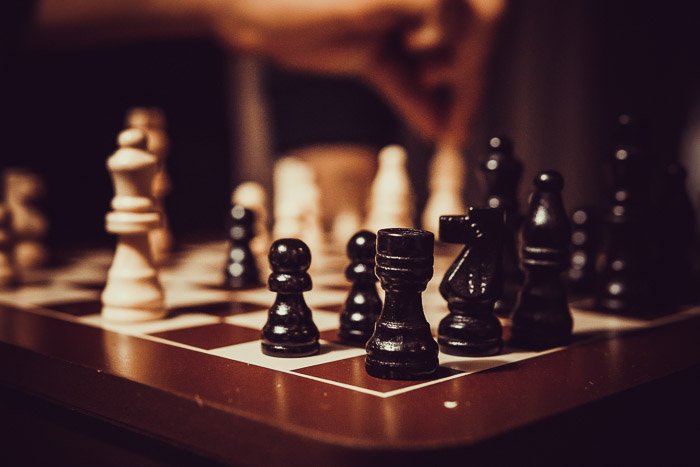
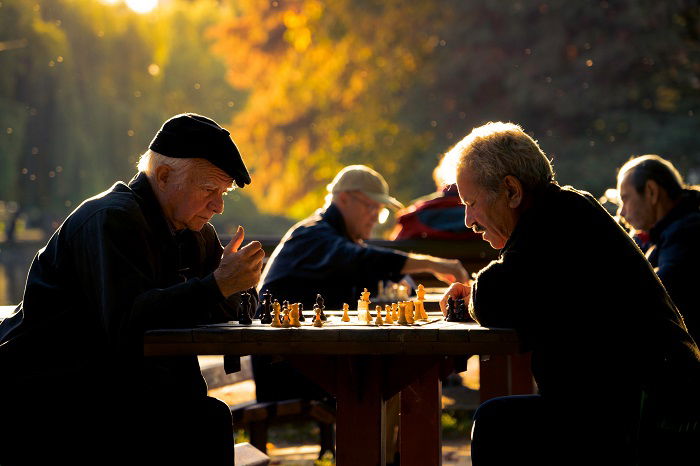
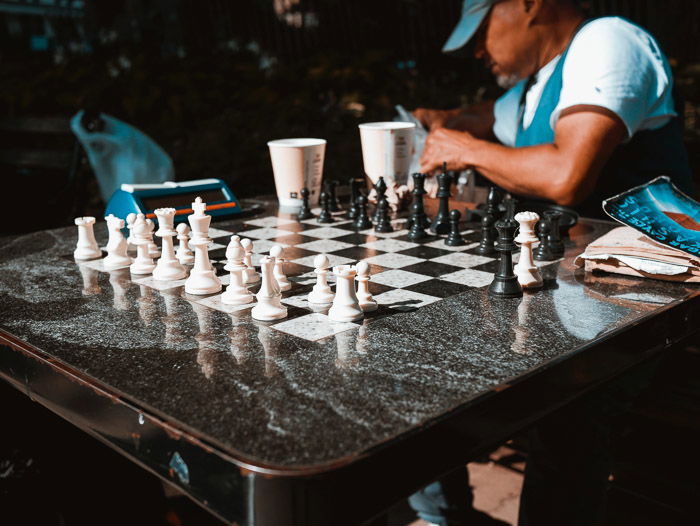

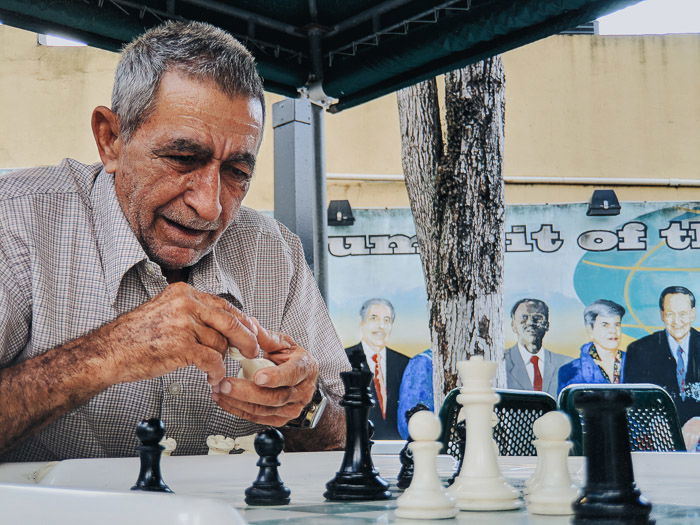
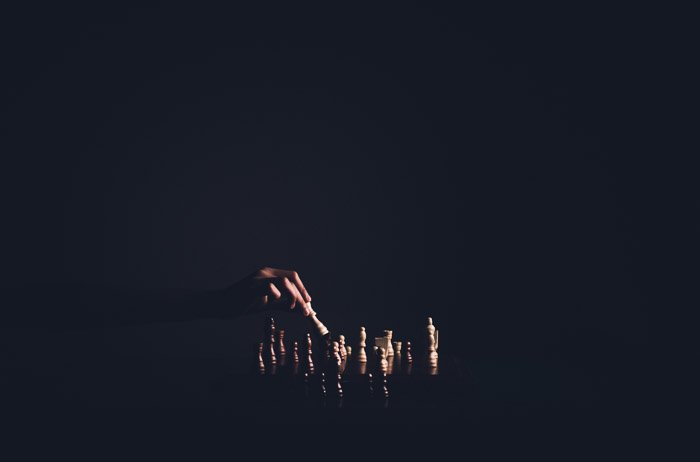
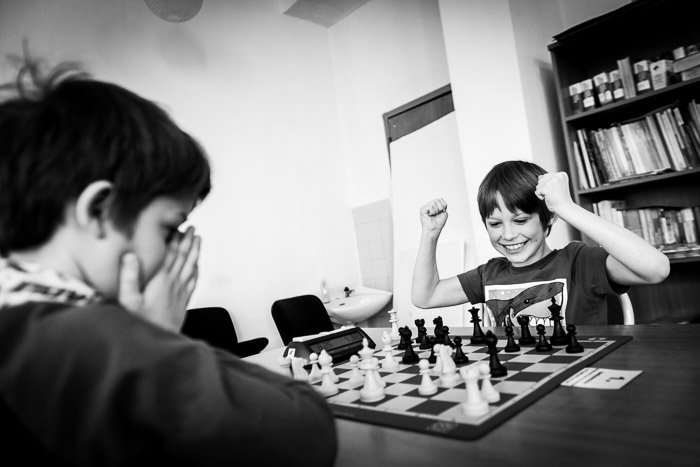
title: “8 Chess Photography Tips For Professional Chess Photos” ShowToc: true date: “2023-02-14” author: “Janet Kahalehoe”
In this article, we’ll guide you through shooting your first tournament to help you capture awesome chess game photos.
Chess Photography Tips
8. Don’t Disturb the Players
Chess involves a lot of concentration. As a photographer, you need to be careful not to disrupt a game while you’re taking pictures. The first tip to avoid disturbing players is don’t get too close to them. Try to stay at least six feet away if possible. It offers enough distance to let you shoot nice images without getting in the way. You should also try not to make too much noise. In many ways, watching chess is like being in a golf tournament. Don’t talk while people are playing. Just observe and take chess game photos quietly. Finally, don’t move around too much. Once you find your place, stay there during the game. If your location doesn’t seem ideal, move to a better spot with purpose. Keep your distance from the players and walk carefully to the location you desire.
7. Use a Zoom Lens to Capture Details
Since you need to maintain distance from the players, it only makes sense to use a zoom lens. That way, you can take close-up or even medium shots without having to move around too much. Thankfully, you don’t even need an expensive zoom lens to shoot chess photos. All you need is your 18mm-50mm kit lens to get the job done. The only caveat is that kit lenses don’t work well in low-light situations. Most of them have a maximum aperture of f/3.5 which don’t let a lot of light in. A lot of manufacturers also offer versions that go as low as f/2.8. They may be a tad bit more expensive than your kit lens, but at least they let you work better in the dark. If you shoot in dark locations all the time, it’s better to get a prime lens, instead. Unlike a zoom lens, it has a fixed focal length that prevents it from zooming in. What makes it great is that it often has a wider aperture which is what you need. A great example of such lenses is the 85mm portrait lens. You get a maximum aperture of about f/1.8 or even f/1.4. That’s enough to let you shoot without having to bump your ISO too high ( we’ll talk more about ISO later). Apart from the aperture, 85mm also has the perfect focal length for chess photography. Although it can’t zoom, it still allows you to shoot close-ups of your subjects even when you’re far away. And since it’s a portrait lens, it will make your players look pleasing in your images.
6. Turn On Silent Mode
Remember that clicking sound your DSLR or mirrorless camera makes? Sometimes it can be so loud and can distract players. A simple way to avoid this is by turning on Silent Mode. Different manufacturers have different names for the Silent Mode. Nikon calls it Quiet Mode, Canon calls it Silent Shutter, and many mirrorless brands such as Sony use the term Silent Shooting. If you’re using a DSLR’s Silent Mode, you’ll still hear the shutter slap since it takes photos mechanically. The only difference is the sound is more subdued as compared to the normal shutter click. If you’re using a mirrorless, there’s a good chance you won’t hear anything at all. The reason is that it doesn’t use mechanical parts to take photos. In many ways, it’s the ideal device to use in a chess tournament. Remember that every camera has a different way to activate the Silent Mode. So make sure you read the manual to figure out how to use it on your device.
5. Best Settings for Chess Photography
Apart from activating the Silent Mode, you’ll have to adjust the exposure settings as well. The first in line is choosing your ISO. This setting is responsible for changing the sensitivity of your sensor to light. The lowest value is typically 100 which is perfect for use on a sunny day because there’s plenty of light. But if you’re shooting chess photos in a dark room,100 is not going to be enough. So bump the ISO value until your photos look properly exposed. Just remember to keep it 800 or under. Otherwise, you’ll end up with image noise which doesn’t look nice. Next, set your shooting mode to Aperture Priority. Doing so allows you to choose your Aperture setting and let the camera decide what the Shutter Speed would be. Once you’re in Aperture Priority, set it to your maximum aperture (preferably f/1.4 or f/1.8). That way, you can blur your background and isolate your subjects from the rest of the scene. Even when using Aperture Priority, you still need to watch your shutter speed. If it goes any lower than 1/60th, you’ll risk ending up with motion blur. To avoid this problem, bump up the ISO or open up your aperture to let more light in.
4. Try Different Angles to Capture the Tournament Mood
Don’t stay in the same spot whenever you’re taking photos. We advise that you cover every good angle possible to make your chessboard photography more exciting. First, do a long or medium shot of players sitting at the table. That means you need to either include their entire bodies or at least the half part in your frame. Doing so allows your viewers to see not just your subjects but also the environment they are in. Next, do a close-up shot of the players. It creates an intimate space that brings in your viewers into the game. All the detail you capture will make people feel like they’re there watching the tournament themselves. You should also consider unusual angles such as overhead shots if possible. You can also try tilting your camera slightly (a.k.a. Dutch angle) to create some suspense in the picture. While trying different angles, be mindful of not disturbing players. As we mentioned earlier, don’t move around too much. Instead, try to stick to one or two spots during the game and stay there.
3. Capture Chess Players Facial Expressions to Show Emotion
In most cases, chess players maintain a poker face throughout the game. But there are also instances when they react to surprising moves by their opponents. As a photographer, it’s your job to document these candid moments. It’s difficult to know when a player would make a facial expression if at all. But there are a few ways you can anticipate reactions when shooting a chess game. For instance, you can wait for a player to make a move. Once they pick up a chess piece, focus your lens to the opponent’s face and wait for a response. There’s a good chance you won’t get any reaction from the opponent at all. But you might get lucky every once in a while especially if your subject encounters an unexpected move from their opponent. You should also pay attention when the game is about to end. It’s during this time when some players get more intense as they attack an opponent or defend themselves. You can expect a lot of raw emotions to unfold during this stage. Keep your camera turned on and wait until the game is over. This is the moment when most people finally let their emotions out. Shoot both the winner and the loser, and aim to capture how they feel after the bout.
2. Take Close-Ups of Chess Pieces
We mentioned earlier that it’s crucial to shoot from different angles including close-ups. And chess pieces make great points of interest for that. Of course, a long lens would be necessary to shoot close-ups during a tournament. So make sure your lens can zoom in tight to capture the photos you need. During a game, you can include fingers of players as they move the chess pieces about. In many ways, this would equivalent to your action shot in traditional sports photography. But you can also just try a still life photography approach and shoot just the chess pieces themselves. You can create wonderful pictures especially if the lighting is good. And don’t forget to look for stark shadows that make the pieces look imposing. Since you don’t need people when shooting chess pieces, you can do it before or after the tournament. That way, you can get really close to the board and try different angles.
1. Shoot Candid Portraits of Chess Players
Chess is more than just the game. It’s also about people and friendships. So don’t turn off your camera once the game is over. Talk to the chess players and take their portraits. You should also look around and wait for fun candid moments between all the participants in the tournament. Shooting portraits during a tournament allows you to bond with the players. Forming relationships with other people will make it a whole lot easier for you as a photographer. The next time you go to a chess game, you can expect people to invite you to take their photos.
Conclusion
Chess photography may be highly specialized, but it teaches you a lot about photography in general. It allows you to hone your skills as a portrait or even a still life photographer. It teaches you to anticipate crucial moments without pressure. Go to a chess club and start taking pictures there. You’d be surprised to see how exciting watching and documenting a game can actually be. For more insider tips, check out our articles on baseball photography or garden photography!









